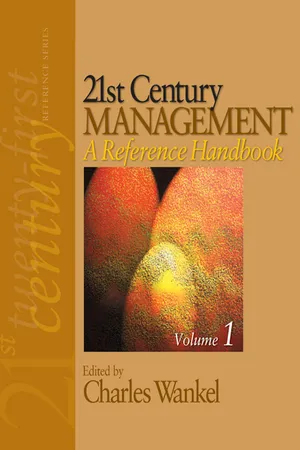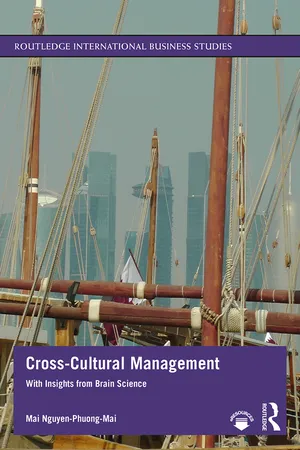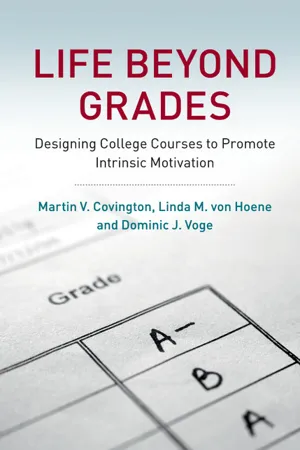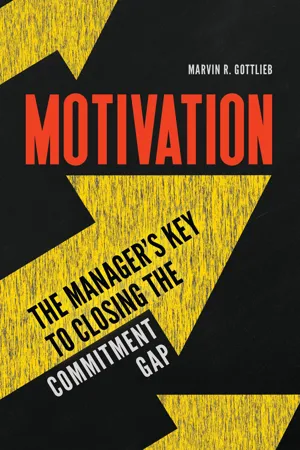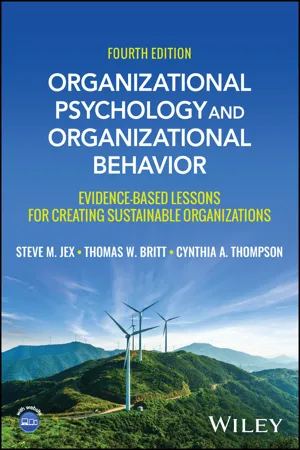Business
Intrinsic Motivation
Intrinsic motivation refers to the internal drive and satisfaction that individuals experience when engaging in an activity for its own sake, rather than for external rewards or pressures. In a business context, fostering intrinsic motivation can lead to higher job satisfaction, creativity, and productivity among employees, as they are driven by personal fulfillment and enjoyment in their work.
Written by Perlego with AI-assistance
Related key terms
1 of 5
11 Key excerpts on "Intrinsic Motivation"
- No longer available |Learn more
- (Author)
- 2014(Publication Date)
- The English Press(Publisher)
________________________ WORLD TECHNOLOGIES ________________________ Chapter-1 Motivation ________________________ WORLD TECHNOLOGIES ________________________ Motivation is the driving force which causes us to achieve goals. Motivation is said to be intrinsic or extrinsic. The term is generally used for humans but, theoretically, it can also be used to describe the causes for animal behavior as well. Here we, refer to human motivation. According to various theories, motivation may be rooted in the basic need to minimize physical pain and maximize pleasure, or it may include specific needs such as eating and resting, or a desired object, goal, state of being, ideal, or it may be attributed to less-apparent reasons such as altruism, selfishness, morality, or avoiding mortality. Conceptually, motivation should not be confused with either volition or optimism. Motivation is related to, but distinct from, emotion. Motivation concepts Intrinsic and extrinsic motivation Intrinsic Motivation refers to motivation that is driven by an interest or enjoyment in the task itself, and exists within the individual rather than relying on any external pressure. Intrinsic Motivation has been studied by social and educational psychologists since the early 1970s. Research has found that it is usually associated with high educational achievement and enjoyment by students. Explanations of Intrinsic Motivation have been given in the context of Fritz Heider's attribution theory, Bandura's work on self-efficacy, and Deci and Ryan's cognitive evaluation theory. Students are likely to be intrinsically motivated if they: • attribute their educational results to internal factors that they can control (e.g. the amount of effort they put in), • believe they can be effective agents in reaching desired goals (i.e. the results are not determined by luck), - Charles Wankel, Charles B. Wankel(Authors)
- 2007(Publication Date)
- SAGE Publications, Inc(Publisher)
This advice has been embraced whole-heartedly by many scholars and practitio-ners, particularly in the field of public administration, which has shown that public employees are distinctively attracted to the intrinsic nonmonetary qualities of their work environ-ment, mainly when compared to private-sector employees. This is very important and pragmatic given the fact that public organizations often lack the financial resources to rely heavily on monetary incentives as a major motivational strategy. However, some public administration scholars of-ten characterize Intrinsic Motivation in ways that are in-herently incompatible with our 21st-century organizational environment and prevailing human relations principles. Consequently, the purpose of this chapter is to present a conceptual framework that can be used to explore and un-derstand Intrinsic Motivation in public organizations. Intrinsic Motivation What is Intrinsic Motivation? Intrinsic Motivation is a sub-category of employee motivation. Kanfer (1990) defines employee motivation as the energy within employees that directs and sustains their efforts in organizations. Stated another way, employee motivation is the fuel that propels individuals to act in certain ways and toward certain goals. This energy is generated from an expectation that internal needs will be satisfied. These internal needs can be physi-ologically based (such as the needs for food, shelter, and sleep) or psychologically based (such as the needs for love, belongingness, and self-esteem). Maslow (1943) catego-rizes the psychological and physiological needs as higher level and lower level needs, respectively. 194 • ORGANIZATIONAL BEHAVIOR While the psychological and physiological needs are very important to individuals, there are real differences between these needs. According to White (1959) one of the major differences between psychological and physiologi-cal needs is their importance to individuals after they are fulfilled.- No longer available |Learn more
How to Thrive at Work
Mindfulness, Motivation and Productivity
- Stephen J Mordue(Author)
- 2021(Publication Date)
- Critical Publishing(Publisher)
Finding your motivation mojo: making a start is the hardest part 131 131 When someone sets their goals from their personal value perspective and considers what they want to achieve for themselves from an internal viewpoint they are being inter-nally or intrinsically motivated. For some, it might be for example, ‘ I want to do a good job and utilise my skills and knowledge ’ , or ‘I want to enhance my knowledge’ . Intrinsic moti-vators fuel behaviour that is enjoyable and purposeful and provides sufficient motivation that people persist in undertaking the task (Cerasoli et al, 2014 ). Intrinsic Motivation is born out of engaging in something personally rewarding. Such people are the ‘learning- orientated’ people we found out about in Chapter 1 . Extrinsic motivation relies on rewards or the desire to avoid punishment. We are rewarded for doing our job with a salary or we avoid the punishment of a reprimand by our manager by getting that report done on time. There is not a simple straightforward binary here that defines intrinsic as good and extrinsic as bad, although, as we shall see, intrinsic motiva -tors in many job roles are more likely to promote motivation and job satisfaction while mitigating stress. Extrinsic rewards do have their place. Incentives (things like bonuses for example) were shown to produce a 22 per cent increase in performance but largely in manual work rather than cognitive work (Taylor, 2015 ). Pink ( 2018 ) suggests that extrin-sic motivators like salary have their limits and explains that once someone has enough money to achieve a good standard of living, paying them more doesn’t necessarily result in enhanced motivation. In fact, he notes that further extrinsic rewards can actually demo-tivate. I’m willing to participate in a study to check if this is true. - eBook - PDF
Cross-Cultural Management
With Insights from Brain Science
- Mai Nguyen-Phuong-Mai(Author)
- 2019(Publication Date)
- Routledge(Publisher)
For example, they can approach the less fortunate at the top level of the Inverted Pyramid Model (Chapter 6) as unique individuals with personal stories and not as a number; 66 they can practice perspective taking by imagining themselves in the position of the poor; 67 and their atti- tude will change if they and the poor are in the same ingroup. The same counts for companies that need to balance between the urge to maximize profits and the necessity of doing good. Not only will this balance bring well-being to the employees, an ethical business that does not prioritize money above all else is also what job seekers and customers nowadays demand. 10.4 Intrinsic Reward Intrinsic reward is identified by the nature of our work. In the modern era, our work is more and more driven by a sense of purpose. Fundamentally, it revolves around committing to mean- ingful purpose, choosing the best way to fulfill that purpose, having the competence to perform, and making progress to achieving the purpose. In this section, we will briefly address the universal Cross-Cultural Motivation 207 207 advantages of meaningful work, the extent to which it is influenced by culture and context, and strategies to cultivate meaningful work among employees. 10.4.1 The Benefits of Intrinsic Meaningful Work Universally, meaningful work is a fundamental component of well-being 68 and hence, a key motivator to work. It is the subjective experience that what we are doing is interesting, challen- ging, and significant, that it facilitates personal growth and contributes to the greater good. 69 It’s a kind of work that would make a person get up early, stay up late, and invest extra time and effort to get things done because they want to, not because they have to. Professor Michael Pratt at Boston College had an illustrative way to explain it by using the old tale of three bricklayers. - Des Hewitt, Brittany Wright, Author(Authors)
- 2018(Publication Date)
- SAGE Publications Ltd(Publisher)
As an individual, we may experience a sense of challenge differently from another person. What is intrinsically motivating for one person may not be for another. It is true to say as well that levels of Intrinsic Motivation may rise or fall over a period of time. Just because something is intrinsically motivating for you as a child is no guarantee that you will have the same Intrinsic Motivation later in on life. It is also quite logical that someone can be both intrinsically motivated and extrinsically motivated for an activity. For instance, a pupil in school may love reading Charles Dickens as an activity in itself, whilst also aspiring to achieve a high grade at the end of year exam in English because this will allow them to pass to the next stage of the school system at the age of 16 years. Learners can have different things they are interested in. We can have an interest in an activity like reading, but this is no guarantee that it is intrinsically motivating in itself. Logically, but unlikely, is the possibility that someone may be intrinsically motivated but have no interest in something. It is possible, for instance, that someone may be motivated to sit exams without having an interest in exams. It is, however, counter-intuitive. Bound up in the concept of Intrinsic Motivation is the idea of ‘interest’. Zimmerman and Schunk (2008) define this as how much someone likes or is engaged in an activity. Interest can be looked at in different ways. Broadly, we can categorise this in two main ways – internal or personal and external or situational forms of interest: Internal or personal interest is our liking for certain topics, pursuits or areas of learning. A child might love learning about dinosaurs. One teacher recounts the tale of a 6-year-old pupil she taught. They did a simple project on fossils. His mum later said that he was so interested in this topic, that it became a lifelong interest- eBook - PDF
Life beyond Grades
Designing College Courses to Promote Intrinsic Motivation
- Martin V. Covington, Linda M. von Hoene, Dominic J. Voge(Authors)
- 2017(Publication Date)
- Cambridge University Press(Publisher)
What other kinds of intrinsic rewards can instructors imbed within academic work that will encourage intrinsically rich personal meaning to emerge? Several possibilities have been the subject of our research pro- gram. These include self-improvement as a source of rewards as well as the benefits of novelty, surprise, and the offbeat. Self-Improvement Another motivational trigger for intrinsic task engagement is a growing sense of personal improvement and mastery over events. In order to explore these dynamics, we asked undergraduates to recall a time when they were coaxed, bribed, or otherwise coerced into taking up some new activity that in the beginning commanded little enthusiasm, but that in time became a source of great personal satisfaction. Virtually every student had at least one such experience to relate. The circumstances of moving from “chore to joy,” as we put it, varied widely, as did the activities themselves, although learning to play a musical instrument was the most frequently mentioned extracurricular event, and learning a foreign lan- guage dominated scenarios drawn from school settings. At five different points in a timeline narrative, students rated the importance of each of several reasons as motivating to continue learning. These reasons included literally being paid in one form or another (e.g., borrowing the family car; increased weekly allowances) as well as feeling a sense of obligation to comply; fearing the withdrawal of privileges if they 96 Prospects for Intrinsic Task Engagement did not persist; and becoming increasingly skillful or knowledgeable. Increasing one’s knowledge and skills was consistently rated as the most important of these motivating factors at each of the five points from the inception of learning until mastery was achieved, and irrespective of the nature of the activity undertaken. - eBook - PDF
Educational Psychology
Reflection for Action
- Angela M. O'Donnell, Johnmarshall Reeve, Jeffrey K. Smith(Authors)
- 2012(Publication Date)
- Wiley(Publisher)
Students work hard not because they enjoy what they are doing but because they want to receive the reward or avoid the punishment. Extrinsic motivation Intrinsic Motivation The inher- ent desire to engage in one’s interests and to exercise and develop one’s capacities. How Can I Use This? How will you motivate students? Which motivational strategies do you currently have high confidence in? Figure 10.4 Psychological Need Satisfaction Is the Source of Intrinsic Motivation AUTONOMY Satisfaction of the Psychological Need: COMPETENCE Satisfaction of the Psychological Need: Intrinsic Motivation The Experience of RELATEDNESS Satisfaction of the Psychological Need: What Does This Mean to Me? Do different types of motiva- tion explain why you want to become a teacher? Intrinsic and Extrinsic Motivation 343 exists as an in-order-to motivation (as in, Do this in order to get that). This is the behavioral request, whereas that is the incentive or consequence. In short, extrinsic motivation is an environmentally created reason to initiate or persist in an action. Trying to extrinsically motivate students to engage in the school curriculum is a widely used strategy (Kohn, 1993). Common positive reinforcers in the classroom include praise, stickers, privileges, bonus points, tokens, marbles in jars, certificates, attention, high grades, scholarships, honors, trophies, prizes, public recognition (e.g., the school’s honor roll), food, awards, money, and smiles of approval. The benefit of extrinsic motivation is that it elicits students’ willing com- pliance. Generally speaking, students who are offered an attractive reward to engage themselves in a task are significantly more likely to do so than are students who are not offered a reward. - No longer available |Learn more
- Jackie Scruton, Belinda Ferguson, Susan Wallace(Authors)
- 2014(Publication Date)
- Critical Publishing(Publisher)
Wlodkowski also suggests that Intrinsic Motivation – motivation that arises from within the learner rather than being driven by out-side imperatives – can be governed by emotions. We can see this from the perspective of both the teacher and the learner. Look back at Nisha’s story (page 30–31), where on starting a new job she was both worried and frightened about whether she could meet its demands. Ed had similar concerns about being a student on his course. Both Nisha and Ed, you will remember, were supported in their journeys by their peers. Your learners may view their adult learning experience as a welcome personal challenge. This could be an intellectual challenge; a challenge in terms of risk taking; a challenge in doing something new or in meeting new people; or a challenge in learning a new skill. Or they may be motivated as a result of their family history, having seen other family members return to learning and recognising that it may ‘open doors’. Intrinsic Motivation may also take the form of a desire to make up for previous lost oppor-tunities. Perhaps the school curriculum was not ‘right’ for them or they were excluded from education. Or they may wish to break a cycle of poor educational achievement by supporting their own children. Maxted ( 1999 ) suggests that family life is the foundation for learning for children and that 85 per cent of their learning takes place in the home. Or perhaps the adult learner is driven simply by the need to prove to themselves and others that they can ‘do it’. The National Adult Learning Survey ( 2010 ), for example, found that 49 per cent of respond-ents entered learning in order to develop new skills and 32 per cent entered in order to boost their self-confidence. Critical thinking activity You have a new group of learners on your course. They are made up of a mix of ages » and experiences, but within the group you have a number of adult learners. - eBook - ePub
Sustaining Workforce Engagement
How to Ensure Your Employees Are Healthy, Happy, and Productive
- Lonnie Wilson(Author)
- 2019(Publication Date)
- Productivity Press(Publisher)
In general, there are two types of motivation: extrinsic and intrinsic. Extrinsic motivators come from “an external locus of causality”, that is, from outside of the individual. Examples are money, awards, prestige, power and social position, which all come from someone else or somewhere else.Intrinsic motivators, on the other hand, are those that arise from within the individual. These include doing things for the pure joy of doing them. They are the motivators which cause people to take up hobbies, work for volunteer organizations and, for our purpose, the motivators which cause a natural enjoyment at work.Maslow on motivation – His hierarchy of needs The theoryIn his classic book Motivation and Personality (1954), Abraham Maslow described a multi-level theory of human motivation (Figure 11.1 ). In it, he stated:Figure 11.1 Maslow’s hierarchy of needs. (From www.simplepsychology.com )■ To be motivated is to be driven (to act upon), to satisfy a need. ■ Until the needs, at that level, were satisfied, those needs would push all other needs to the background. ■ However, once that specific need was satisfied, it was no longer a motivating factor and the needs of the next level would be the “driver of interest” to the person. ■ There was a natural progression up the hierarchy, and although there was some regression and return, the overall lifelong process of the individual was to ascend the hierarchy. ■ Maslow said “man is a wanting animal and is never satisfied for very long”, and ■ “Humans are never satisfied, except in a one-step-along-the-way fashion and the wants arrange themselves in some sort of a hierarchy” ■ There were five levels to his hierarchy of needs. Starting from the most basic, they were: a. The physiological needs of food, water, shelter; often called the survival needs b. The safety needs of protection, security and freedom from danger. i. Levels one and two, taken together are called “the basic needs”. c. The belongingness needs including friends, relationships and intimacy. d. The esteem, or ego, needs of prestige and a sense of accomplishment. - eBook - PDF
Motivation
The Manager's Key to Closing the Commitment Gap
- Marvin R. Gottlieb Ph.D.(Author)
- 2017(Publication Date)
- Praeger(Publisher)
One of the more recent organizational initiatives that seeks to create extrinsic motivation is the focus on employee well-being. There is some Table 3.1 Successful Incentive Programs Factors Actions • An experimental attitude Are you (and the organization) willing to try different ideas for incentives in order to arrive at the ones that work? • Continual fine-tuning of the system Are you operating in a continuous improvement culture? • Input from people within the system Have you polled, or can you poll your employees quantitatively and qualitatively about what hygiene or motivational factors are missing in the work environment? • Ongoing evaluation of the effectiveness of the system Will you put success criteria in place before implementing incentives, and measure success at regular intervals? • A desire to attain high standards Will you set ambitious but achievable objectives for both the group and the individuals—with their input and agreement? Intrinsic and Extrinsic Motivation 51 evidence that employers that invest strategically in well-being issues experience greater outcomes that measurably impact business perfor- mance. “Well-being” is an elusive term. It can mean different things to different people. A review of the literature tends to converge the factors that associate well-being with engagement: high stress levels, both at home and in the office; financial concerns; poor physical health; and demands for greater levels of productivity. A new study by Virgin Pulse in association with Workforce was recently presented in a white paper enti- tled, State of the Industry: Employee Wellbeing, Culture and Engagement in 2017, which details key findings of the survey results. 15 The respondents to the survey come from a broad range of industries, organization sizes, and geographic distribution. - eBook - PDF
Organizational Psychology and Organizational Behavior
Evidence-based Lessons for Creating Sustainable Organizations
- Steve M. Jex, Thomas W. Britt, Cynthia A. Thompson, Cynthia A Thompson(Authors)
- 2024(Publication Date)
- Wiley(Publisher)
Deci (1975) initially emphasized the importance of intrinsic moti- vation for task enjoyment and persistence, where an individual performs a task because of an inherent enjoyment in the task itself, rather than for extrinsic reasons such as pleasing others or making money. Deci argued that intrinsically motivating tasks feel autonomous, coming from the individ- ual, whereas extrinsically motivating tasks feel controlled, with performance having more to do with external demands than one’s inherent interests. Employees who truly enjoy the work they do will feel more autonomy at their job, which should lead them to persist in their work even when external factors, such as being monitored by a boss, are absent. Another important aspect of SDT is that individuals develop to their fullest potential when they are able to satisfy three types of needs which are thought to be innate: (1) need for autonomy or to exercise control over their environment, (2) need for relat- edness or to feel connected to others, and (3) need for competence or to feel as though one has an impact on one’s outcomes and their environment. When applied to the work domain, this aspect of the theory sug- gests that anything in the work environ- ment that helps people to satisfy these needs will be motivating to the individual. SDT appears to work well with inherently interesting jobs where individuals can gain enjoyment from the job itself, but what about jobs that provide little inherent interest? For example, it is hard to imagine employees showing Intrinsic Motivation for tasks that are highly monotonous and uninteresting (e.g., checking for errors in database after database). Subsequent modifications to SDT accommodate these types of tasks. Ryan and Deci (2000) present an elaborated version of SDT where extrinsic motivation is separated
Index pages curate the most relevant extracts from our library of academic textbooks. They’ve been created using an in-house natural language model (NLM), each adding context and meaning to key research topics.

